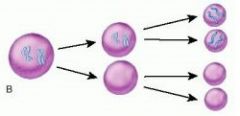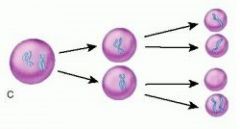![]()
![]()
![]()
Use LEFT and RIGHT arrow keys to navigate between flashcards;
Use UP and DOWN arrow keys to flip the card;
H to show hint;
A reads text to speech;
44 Cards in this Set
- Front
- Back
|
The Eukaryotic Cell Cycle |
G1 phase, S phase, G2 phase, (Interphase) M phase (mitosis) |
|
|
G1 and G2 phase |
* checkpoints: G1: is DNA okay for replication G2: is the replicated DNA okay
replication of macromolecules but not DNA |
|
|
S Phase |
Replication of DNA |
|
|
M phase |
nuclear division |
|
|
Cytokenesis |
Cell divison |
|
|
G0 (quiscense) |
resting or dormant phase most cells except hair, skin, and blood cells are in this phase |
|
|
What cells are permanently in G0 (do not regenerate) |
nerve cells muscle cells |
|
|
Cyclin Dependant Kinase (CDK) |
progression past checkpoint depends on the activation of these by binding them regulatory cyclin subunits |
|
|
P53 |
a break in the cell cycle to ensure that it doesnt occur uncontrollably
- most cancer cells have a defected P53 |
|
|
Cancer |
a malignant growth due to multiple gene mutations |
|
|
Oncogenes |
In cancer cells positive regulators responsible for increased divison gain of function |
|
|
Tumour suppressor genes |
negative regulators get rid of mutated gene, cancer stops loss of function |
|
|
Cancer is based on ________ |
chance (ie it can happen at any point) |
|
|
Homologous chromosome |
Maternal and paternal chromosome |
|
|
ploidy depends on how many _________ chromosomes there are |
parent
ie. maternal and paternal pair = diploid |
|
|
Haploid |
n number of chromosomes sperm cells |
|
|
Diploid |
2n somatic cells zygote |
|
|
Mitosis events and ploidy |
G1 (2n) G2 (2n) Prophase (2n) Prometaphase (2n) Metaphase (2n) Anaphase (4n) Telophase (4n) Cytokenesis (4n)
each daughter cell is 2n |
|
|
Mitosis number of chromosomes, chromatid per chromosome |
G1 (4, 1) G2 (4, 2) Prophase (4,2) Prometaphase (4, 2) Metaphase (4, 2) Anaphase (8, 1) Telophase (8,1) Cytokenises (8,1)
each daughter cell (4, 1) |
|
|
G1 |
Centrosome duplication |
|
|
Prophase |
nuclear envelope disappears condensation of DNA |
|
|
Prometaphase |
microtubules attach to kinetechore |
|
|
Metaphase |
chromosomes line up on metaphase plate |
|
|
Anaphase |
microtubules attached to centromere shorten while the microtubules outside lengthen to also lengthen the cell |
|
|
Telophase |
nuclean envolope forms it is still ONE cell |
|
|
Nuclear envelope in plants vs animal cells |
plant: cell wall animal: contractile ring |
|
|
What is the cell cycle called in prokaryotes? |
binary fission |
|
|
Prophase I |
homologous chromosomes form a tetrad and synapsis (crossing over occurs) occurs between non sister chromatids |
|
|
Meiosis I is called _____________ |
reductional division |
|
|
Cell starts as ________ before Meiosis I and 2 daughter cells are ________ |
2n, diploid n, haploid, two chromatids per chromosome |
|
|
In meiosis I: sister chromatids and centromeres |
do NOT split unlike mitosis and M2 |
|
|
After P1 sister chromatids are ___________ due to __________ |
not identical, crossing over |
|
|
Meiosis II |
n to n 4 daughter cells, each has two chromosomes (but remember n = 2) one chromatid per chromosome centromeres and sister chromatids separate during anaphase II |
|
|
First division nondisjunction (Anaphase I) |

2 triploid zygote and 1 haploid zygote |
|
|
Second division nondisjunction (Anaphase I) |

2 diploid zygote 1 triploid zygote 1 haploid zygote |
|
|
Aneuploid |
gamete has either 0 chromosomes or 3 chromosomes |
|
|
Trisomy 21 |
causes down syndrome can occur in smaller chromosomes but if it were to happen in larger chromosomes zygote would not survive |
|
|
Frequency of chromosome non disjunction _____________ |
increases with age |
|
|
Nondisjunction could be due to ___________ |
a polar spindle |
|
|
Bacteria do not have __________ |
meiosis |
|
|
Three ways of genetic diversity in prokaryotes |
1. conjugation 2. transformation 3. transduction |
|
|
Conjucation |
Bacterias attach to each other through a pilus and transfer plasmids through horizontal gene transfer |
|
|
Transformation |
a dead bacteria's DNA can fragment and enter a living bacteria (Griffith's experiment) |
|
|
Transduction |
bacteriophage DNA picks up bacterial DNA and once it infects another bacteria it can introduce these new bacterial sequences |

